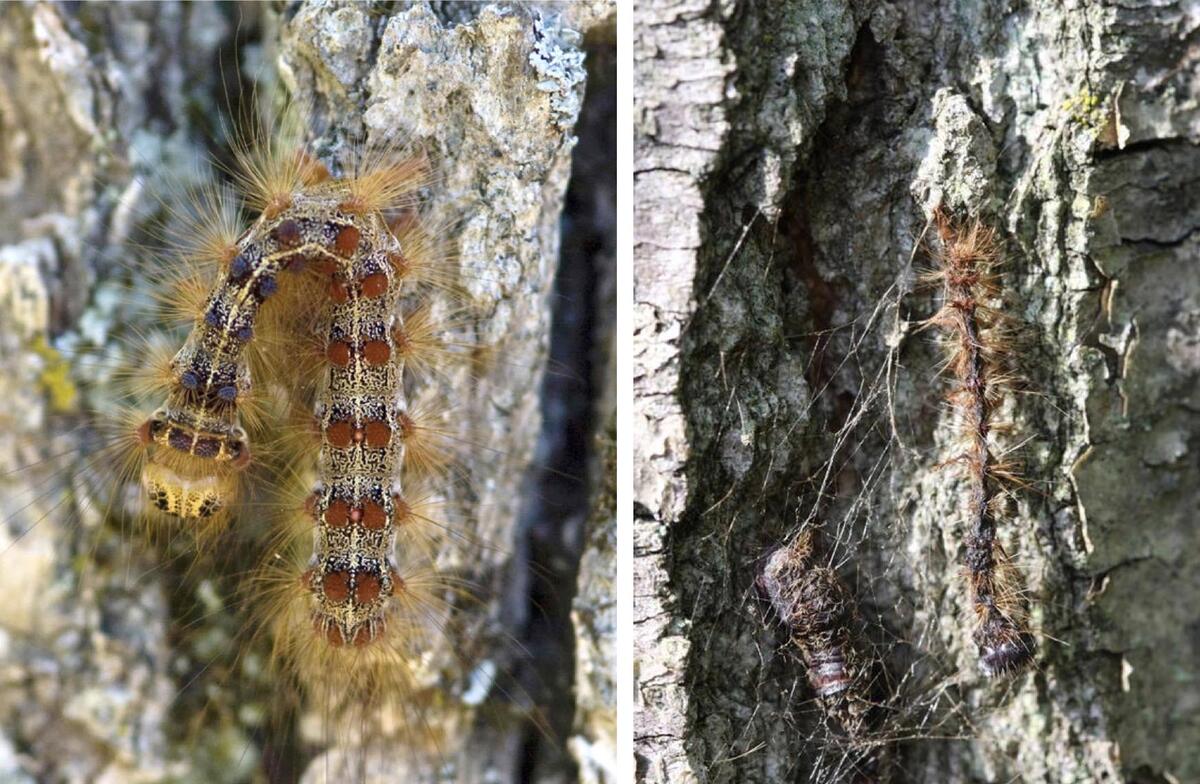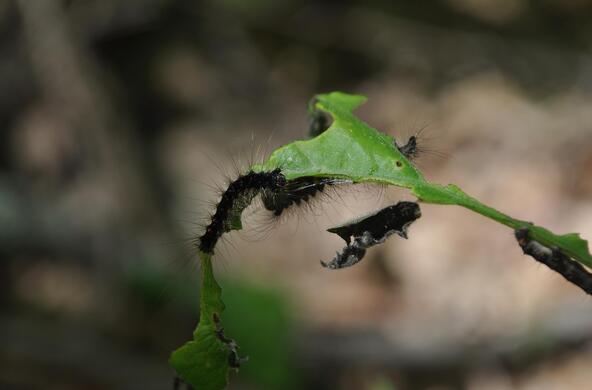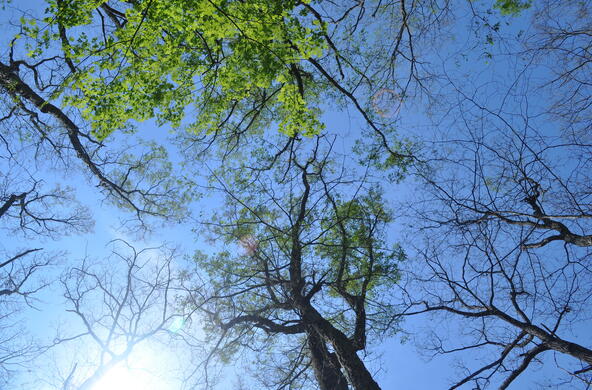Ecologist Clive Jones spent 30 years investigating ecological interactions among spongy moths, white-footed mice, and oak forests as part of a long-term research project on the Cary Institute's 2,000-acre research campus in Millbrook, New York. The invasive moths undergo periodic outbreaks that can last a few years. The last outbreak on our grounds peaked in the early 1990s and we are now at or near the peak of another one. Below, Clive tackles some of the questions he has been fielding from people in the midst of the dramatic hatching of thousands of tiny caterpillars.
Why am I seeing tiny caterpillars everywhere?
Areas in the mid-Hudson region are experiencing spongy moth outbreaks, with many at or approaching the peak of the outbreak this year. Be prepared to see many larvae (tiny caterpillars) ballooning on silken threads. They will then feed on tree leaves, defoliating the trees as the caterpillars grow. If you walk in the forest there will be a rain of leaf bits and frass (caterpillar poop) from overhead. Many trees will get defoliated, with the caterpillars preferring oaks. Healthy deciduous trees will survive this 7- to 8-week feeding frenzy. Then the caterpillars pupate, emerging as adult moths in late summer. (Adult moths do not feed; they mate and the female lays an egg mass that overwinters.) Many trees will re-grow leaves after defoliation. When the current outbreak is over, the spongy moth will be more or less invisible to most of us for quite some time; 10 years or more. So please remember what you learn during this outbreak — you can tell your kids so that they will know what to expect when it happens again.

Why does it feel like it’s raining caterpillars?
After hatching, spongy moth larvae disperse on silken threads — called ballooning — to find their preferred food, oak leaves. Most go only a few yards, but some can get caught up in the wind and go further. They will keep doing this until they find food, even if it takes a few days. They are not choosing to end up in your hair, clothes, or on the exterior of your house; you and your house just intercepted them as they drifted by looking for a tree. Left alone, they will move up as high as they can and then try ballooning again. When there are many larvae, many more of them balloon than when there are few larvae. This dispersal, as it is called, is the caterpillar’s way of trying to avoid the intense competition for food that would occur if all those larvae stayed on the same tree. Nevertheless, at the peak of an outbreak, there are large numbers of larvae everywhere and they will not be able to avoid competition for food. This does not, however, stop them from trying to get away; it is just that everyone is trying to get away!
So they like oaks. What about hemlocks and other conifers? Are they at risk?
Conifers are not the preferred food but can get eaten in heavily infested areas when caterpillars run out of better food. Conifers struggle to survive if they lose more than 40% of their needles. Understory conifers and isolated conifers in oak forests are most at risk. Conifers in your yard, away from forests, can still end up with caterpillars that disperse in on silken threads. If the trees are small and fully accessible, there are ways to help protect them if needed (fine netting, banding, and spraying with BTK — Bacillus thuringiensis var Kurstaki — which is permitted in New York State).

What will a spongy moth caterpillar eat?
Spongy moth caterpillars have been recorded to eat the leaves of more than 300 species of woody plants. But they have preferences. If oaks are unavailable, then they will eat leaves of trees that are lower on their preference list. It is sort of like finding out that the steak or mushrooms you wanted are not on the menu, so you are going to have to settle for something else because you are hungry. If oak leaves are unavailable, don't be surprised to see them eating your willow or apple — or, at a push, your maple — all the way down to the least preferred items on the menu (in extremis, eastern hemlock). This makes perfect sense, because the choice may only be to eat what is available or starve. However, as we humans know full well, you are not going to get as good nutrition from grass as you will get from steak or mushrooms. So too with the spongy moth; the lower down the menu they have to feed, the less likely they will be able to survive, grow, and reproduce. Running out of good food and indeed, running out of any food, is a major reason why spongy moth populations collapse. Furthermore, insufficient food or lousy food stresses out the caterpillars, reduces their immunity, and makes them much more susceptible to dying from the nuclear polyhedrosis virus.
Are they a threat to my fruit trees?
Protecting fruit trees may be a challenge, but banding can help you remove caterpillars, and BTK spraying is permitted for the spongy moth in New York State. Fruit trees away from forests may get less immigration from spongy moth larvae than trees near the forest. Commercial orchards have control options available to them that are not permitted for homeowners.
What about my garden, do I need to take extra precautions?
There is a very low likelihood of your vegetables or annual/biennial garden plants being damaged, even if they are sitting under oak trees getting defoliated, and especially not if they are away from the trees. Spongy moths eat the leaves of woody plants, especially oaks. Like your kids perhaps, they don’t eat spinach!
I scraped the egg masses off my trees this winter, but I still have caterpillars in my yard. What went wrong?
Dispersal by the early-stage caterpillars is one reason why your diligent effort to remove egg masses from some of your trees may not result in your hoped-for decline in caterpillars. They blew in from nearby! Your local intervention can be overwhelmed by what is happening in your surroundings. Location really matters.
I didn’t realize spongy moth caterpillars were out until I found them all over me. Now I am itching. Could they be the cause?
Spongy moth caterpillars are hairy. These hairs, or setae as they are called, are sharp and tend to break on contact. When the hairs brush up against your skin they can cause irritation for some people. If you have further concerns after experiencing this, speak to your doctor. The simplest way to avoid this while being outdoors is to wear a wide brim hat, and cover your skin if you are going to be in an area where larvae are ballooning on silk or, later in the season, falling off trees.

How do I know it is the spongy moth and not some other caterpillar?
While spongy moths are invasive, tent caterpillars are native and a natural part of our forest communities. You can readily distinguish the spongy moth from eastern tent and forest tent caterpillars. Here is a good article to help you do this: Don't Be Fooled: Eastern Tent Caterpillar vs. Spongy Moth; and a helpful visual. Please note that a recent article at WPDH.com (Poisonous Caterpillars Invade New York: How to Kill Them) not only misidentifies the spongy moth, but also claims that its caterpillars are poisonous; they are not. The hairs on the caterpillars can, however, irritate the skin of some people.
Shouldn't all these caterpillars be eaten up by birds? Where are their natural enemies?
There are natural enemies of the spongy moth. When moth density is high — the case now in many areas of the mid-Hudson — most of these natural enemies just can’t kill enough caterpillars to make a real dent in their numbers. They include birds such as cuckoos, one of the few birds in our region that will eat hairy caterpillars. Smoky shrews will eat caterpillars and pupae. And caterpillar hunter beetles eat — you guessed it — caterpillars. But these and most other natural enemies just can’t keep pace with the rates of increase of the moth population from one year to the next. So at best, they can help an already collapsing population further collapse, but they are not going to end the outbreak on their own. (For more about natural enemies watch: The Spongy Moth in Our Yards and Forests.)
I am seeing dead spongy moth caterpillars. What killed them?
You can do your own forensics. If you see what looks like a desiccated head-down mummified caterpillar on the tree trunk, the killer was the fungus Entomophaga maimaiga. This fungus can kill many caterpillars within a season if conditions are right, which means a wet spring over the next 3-4 weeks, with no period of high temperature of over 80 degrees Fahrenheit lasting more than a few days. (Extended high temperatures can inhibit the fungus.) During the last outbreak in our area in the early 1990s, this fungus caused the outbreak to collapse. The amount of defoliation was very modest (~20%). So let’s pray for rain!
If you see a soggy, smelly caterpillar looking like an inverted, head-down V, then the killer was the nuclear polyhedrosis virus. This virus is always present, but is sub-lethal when spongy moth caterpillars are at low densities. As their density increases, more and more caterpillars are trying to eat a shrinking food supply, and they crowd into protective resting spaces. Lack of food and crowding stresses out the caterpillars, weakening their immunity and making them more susceptible to the virus — which then explodes as an epidemic, killing most of the caterpillars. It is the way most North American spongy moth outbreaks end. So while we should try to avoid stress in our own lives, we might be excused for wishing these caterpillars a short, stressful life!

Will the state and local government help me fight the moth?
NYS Department of Environmental Conservation (NYS DEC) generally does not intervene for spongy moth, so there are no widely available control programs. NYS DEC may occasionally intervene in special circumstances (e.g., picnic grounds in state parks or in high-priority forest areas). NYS DEC does not provide funds for control on private property. Most towns and cities in NYS do not provide funds for control and do not have treatment programs. If they were to do so, they would have to conform to NYS DEC-approved treatment practices.
Why are they spraying in my state and not in New York State?
Each state has different rules and practices with regard to intervention for spongy moth, and different rules as to what is permitted to be sprayed, and by whom. You can find out what is allowed by contacting the relevant agency in your state. NYS DEC does not intervene except in very limited special circumstances, and allows only BTK to be used for area-wide spraying of forests. Such spraying must be carried out by registered applicators and there are a number of particular conditions that must also be adhered to with regard to water bodies, spray drift boundaries and neighbor notification laws (when applicable). If being done by a registered applicator in your area, the first of two BTK applications is conducted around mid-May when larvae are in the early stages, with the second application a week or so after that.
What is your general advice for those of us feeling overwhelmed by the outbreak?
At the peak of an outbreak, there is little or nothing that we poor mortals can do to control it. But Nature has a way! Outbreaks collapse due to diseases — the virus and fungus mentioned above — and food limitation.
As distressing as the outbreak is to homeowners, most trees will come through it just fine; they are remarkably resilient, and the effects on trees and forests are short-lived and minor. Most trees will re-grow their leaves within a few weeks after defoliation. The defoliation could be the last straw for some trees that are already highly stressed, but that will be rare.
For more on this, watch: The Spongy Moth in Our Yards and Forests.

How did this invasive pest get into our forest anyway?
Native to Europe, the spongy moth was imported to North America in the late 1860s by a French entrepreneur and amateur entomologist looking to create a cold-hardy silk moth for the silk industry by cross-breeding the cold-hardy spongy moth with the cold-intolerant Asian silk moth. Spongy moths escaped into his backyard in Medford, MA. This most unfortunate escape continues to haunt our forests and is a reminder of the real and enduring cost of importing and releasing non-native species. To help prevent these kinds of events in the future, learn more about the Tree SMART Trade program.
I’ve lived through previous spongy moth outbreaks and don’t remember people getting rashes from the caterpillars. What’s going on? Has there been a change in our response to them?
The skin reaction/irritation has been known about for a long time, people just tend to forget between outbreaks and the number of people who contact the larvae varies. The setae (hairs) on caterpillars are sharp and can break off on contact. Some people react strongly; others less so. Severity of symptoms can increase with multiple exposures (i.e., develop a hyper-sensitive reaction). Medical professionals suspect that the hairs have histamines that provoke the reaction. While plausible, this does not appear to have been scientifically demonstrated. The allergic reaction can be provoked by all stages of the larvae, but the tiny larvae are the ones that get the most attention because they drift through the air and land on people. Later-stage, larger caterpillars are easier to avoid.
There are two likely reasons why there has been a lot of attention recently. The current outbreak led to massive ballooning events in early May, when the air in some areas was just full of larvae (see the chair image in our Spongy Moth Chronicles Blog). As a result, a great many people had skin contact with them. During previous outbreaks in the 80s and 90s, the web and social media did not exist or were in their infancy. This year, messages spread fast on social media increasing awareness and generating many responses (“I had a rash too”).
Protection is simple. Cover your skin and wear a wide-brimmed hat when walking in the woods. Avoid handling later-stage larvae or wear latex gloves (e.g., if you are removing caterpillars from burlap bands). If someone has a strong allergic reaction they should contact a medical professional and tell them they suspect contact dermatitis from spongy moth larvae. I should point out that this same kind of reaction can be caused by many species of butterflies and moths that have hairy caterpillars.
How much longer will these caterpillars be around? When will it be OK to sit out on my porch?
Based on our observations of development in the forest at Cary Institute in Millbrook, NY made at the end of May, we estimate that most larvae (caterpillars) will have completed development and stopped eating in mid- to late June. There may still be some stragglers, as the development of the caterpillars is not perfectly synchronized. The next stage after the larva is the pupal stage which takes about 2 weeks to complete. Then adult moths will be around for a few days. Brown male moths emerge first, and fly around in search of females, who are larger, light in color, and flightless. Females lay eggs where they emerged and were mated, and egg masses over-winter until next spring, hatching in late April-early May.
If your trees are moderately to fully defoliated, they will very likely re-flush new leaves by the end of July. If there is a summer drought, make sure those trees have adequate water. Add mulch if needed to help retain soil moisture. Most healthy trees will survive two, sometimes three, years of defoliation but additional stress – drought, other pests, diseases – increases the risk of mortality.
So in a while you will be able to sit on your porch without frass, leaf bits, and hairy caterpillars dropping on you! However, if your oaks are defoliated you will have to wait a while longer to be able to sit in the shade!
Should I remove dead spongy moth caterpillars?
The short answer is no. If they died from the fungus and produced resting spores, those spores wash off the carcasses and go into the soil, so that in future years they can germinate, infect and kill spongy moth, potentially helping bring down future outbreaks. If they died from the virus, viral particles can likewise wash into the soil and onto the litter and likewise help bring down future outbreaks. If they died of starvation or some other cause, such as a parasitic wasp or fly that already emerged, or the fungus, or virus, then the carcass will decompose and return nutrients taken from the leaves to the soil and then back to the trees. So it is much better to let the dead caterpillars alone, because when dead they are help and no harm.
Read more on spongy moths and nutrient cycling.
To learn more about spongy moth activity on Cary’s campus, visit Mike Fargione’s blog, The Spongy Moth Chronicles.








